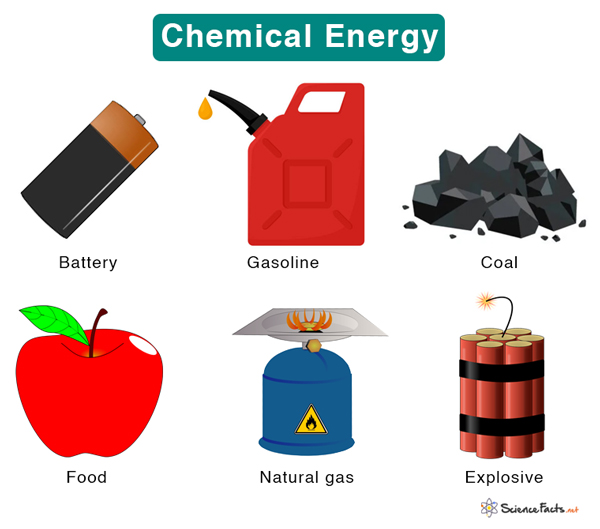Chemical Energy
Chemical energy is a form of potential energy that is stored in the bonds of a compound. It is released through chemical reactions in which old bonds break and new bonds form. The bond that stores the most chemical energy is the double bond.
Chemical energy can be converted into other forms, like thermal and mechanical energy. Living beings need chemical energy to survive. Chemical energy sources are coal, petroleum, natural gas, biomass, and food.
Examples
- Wood consists of hydrocarbons that store chemical energy in their bonds. When wood burns and produces fire, the hydrocarbons are converted into carbon dioxide and water vapor while simultaneously releasing heat and light. Chemical energy is converted into thermal energy and radiant energy. Just like wood, coal also burns and releases heat.
- The food that we eat stores chemical energy. The process of respiration breaks down carbohydrates. It releases chemical energy that keeps us warm and enables us to work. Here, chemical energy is converted into thermal energy and mechanical energy.
- A battery converts chemical energy into electrical energy. When the two terminals of a battery are connected through a light bulb, chemical reactions occur inside the battery allowing electrons to flow around the circuit and lit the bulb.
- Explosives store chemical energy. Chemical energy is released as sound and heat when an explosive goes off.
- Heating packs have chemicals inside them. Most of them contain iron. When a heating pack cracks, the iron reacts with oxygen to produce iron oxide and heat, which keeps us warm.
- Natural gas and petroleum consist of hydrogen and carbon atoms bonded together, storing chemical energy. These fossil fuels tend to ignite in the presence of oxygen to produce carbon dioxide and water vapor. This process is known as combustion and releases a massive amount of energy. We use natural gas in our homes for cooking and heating.
An example of a combustion reaction is that of propane.
C3H8 (g) + 5 O2 (g) → 3 CO2 (g) + 4 H2O (g) + energy
- Biofuels are alternatives to fossil fuels and use energy from living or recently living organisms. They store usable chemical energy and are renewable resources.
- Plants combine energy from the sun with carbon dioxide and water to produce glucose and oxygen, a process known as photosynthesis. When glucose is formed, new bonds are created, and chemical energy is stored. The chloroplast is the organelle that converts sunlight or radiant energy into chemical energy.
- During respiration, the chemical energy stored in glucose is transferred to adenosine triphosphate (ATP) in the cells. Thus, we get the energy to work and run.
How to Calculate Chemical Energy
Chemical energy is calculated by simply subtracting the energy of the products from that of the reactants. The difference is either absorbed or released as heat. Heat is absorbed if the product’s energy is greater than that of the reactants. Heat is released if the product’s energy is less than the reactants. Thus, calculating the chemical energy us to predict whether the reaction will be exothermic (heat released) or endothermic (heat absorbed).
Chemical Energy = Eproducts – Ereactants
FAQs
Ans. Kinetic energy is the energy possessed by a molecule when it is in motion. Chemical energy is stored in the molecular bonds, irrespective of whether the molecule is moving or resting. It is a form of potential energy.
Ans. Autotrophs can manufacture their chemical energy.
Ans. The potential energy of the new bonds formed in the products during a chemical reaction determines the chemical energy.
Ans. An electrolytic cell converts electrical energy into chemical energy.
-
References
Article was last reviewed on Thursday, February 2, 2023









Good